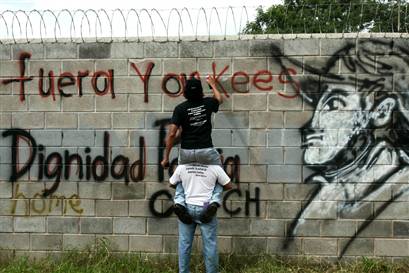Oct. 6, 2008: Demonstrators write "Out Yankees" on a wall outside the U.S. Palmerola military base in Honduras during a protest against American military presence in Latin America. Photo: Edgard Garrido / Reuters file. 
By Nikolas Kozloff, Counterpunch, July 22, 2009
The mainstream media has once again dropped the ball on a key aspect of the ongoing story in Honduras: the U.S. airbase at Soto Cano, also known as Palmerola. Prior to the recent military coup d’etat President Manuel Zelaya declared that he would turn the base into a civilian airport, a move opposed by the former U.S. ambassador. What’s more Zelaya intended to carry out his project with Venezuelan financing.
For years prior to the coup the Honduran authorities had discussed the possibility of converting Palmerola into a civilian facility. Officials fretted that Toncontín, Tegucigalpa’s international airport, was too small and incapable of handling large commercial aircraft. An aging facility dating to 1948, Toncontín has a short runway and primitive navigation equipment. The facility is surrounded by hills which makes it one of the world’s more dangerous international airports.
Palmerola by contrast has the best runway in the country at 8,850 feet long and 165 feet wide. The airport was built more recently in the mid-1980s at a reported cost of $30 million and was used by the United States for supplying the Contras during America’s proxy war against the Sandinistas in Nicaragua as well as conducting counter-insurgency operations in El Salvador. At the height of the Contra war the U.S. had more than 5,000 soldiers stationed at Palmerola. Known as the Contras’ “unsinkable aircraft carrier,” the base housed Green Berets as well as CIA operatives advising the Nicaraguan rebels.

